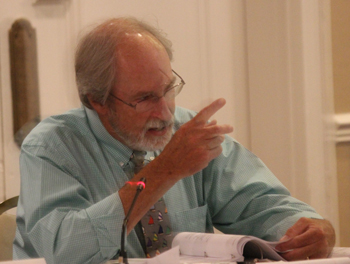State Interests Urge Better
River Herring Protection in
Atlantic Herring Plan
by Laurie Schreiber

David Pierce, NEFMC member. “An increase in bycatch would be inconsistent with Massachusetts attempting to deal with the problems we have with runs,” Pierce said. “We have a moratorium on harvesting, an action we took years ago.” Pierce said the state’s long-term goal is to rebuild the river runs, and has been working with municipalities and recreational fishermen to do so. Fishermen’s Voice photo
PLYMOUTH, Mass.—The Atlantic herring resource is doing well, so the New England Fishery Management Council (NEFMC), at its Sept. 29-Oct. 1 meeting, set fishing specifications for 2016 through 2018 at close to what the specs have been for 2015.
NEFMC also set bycatch caps on river herring and shad, which mix at times with the Atlantic herring resource. But some concerned citizens cautioned NEFMC about allowing any catch of these anadromous species, which are important to local communities when they’re in the river phase of their lives.
According to an April 2015 stock assessment, the Atlantic herring biomass is well above targets, and fishing is well below the established threshold. However, there’s some thought among fishery scientists that the situation can’t last forever. The NEFMC is currently developing long-term control rules for the fishery, in the form of Amendment 8 to the Atlantic herring management plan.
NEFMC approved an acceptable biological catch (ABC) of 111,000 metric tons, compared with an ABC for 2013-2015 of 114,000 metric tons. During the specifications process, NEFMC considered a range of deductions for management uncertainty based on three factors: the Canadian catch of Atlantic herring in the New Brunswick weir fishery; uncertainty in estimates of state waters Atlantic herring catch; and uncertainty around Atlantic herring discard estimates.
NEFMC’s bycatch caps for river herring and shad, for 2016-2018, were based on catch estimates for these species from 2008 through 2014. The caps apply to midwater trawl vessels in the Gulf of Maine and Cape Cod Catch Cap Areas, and to both midwater trawl and small mesh bottom trawl vessels in the southern New England/Mid-Atlantic Catch Cap Area on all trips landing more than 6,600 pounds of Atlantic herring. No caps were adopted for the Georges Bank Catch Cap Area. NEFMC’s overall goal, however, is to encourage the Atlantic herring fleet to avoid river herring/shad and reduce that catch to the extent practicable.
Abigail Archer, from Brewster, Mass., asked NEFMC to keep the river herring/shad cap as low as possible.
“The in-river state recreational fishery has been closed for 10 years now,” said Archer, who works with herring wardens in the 15 towns of Cape Cod. “People are not allowed to go to their local herring runs and catch them for roe, smoking, or bait. Kids never had opportunity to catch river herring from their local runs. It’s part of the culture in Massachusetts towns. I recognize that bycatch in the Atlantic herring fishery is not the only factor affecting river populations. But town wardens are doing their best to maintain fish ladders, keep rivers free of debris, work with scientists, and educate citizens. Despite all this work and the state harvest moratorium, river herring populations continue to decline or to remain steady at low numbers. So until we see an increase, I request you keep the river herring catch cap as low as possible.”
Jud Crawford, with the Pew Charitable Trusts, said the amount of bycatch of river herring/shad should be decided based on their biology as stocks needing protection, not on that of Atlantic herring.
“No one’s allowed to catch them onshore, and they shouldn’t be allowed to catch them at sea,” Crawford said.
“I see this as a lot of recreational anglers do, as an allocation before the ASMFC [Atlantic States Marine Fisheries Commission] gets to regulate this part of a jointly managed fishery,” said Patrick Paquette, a recreational fishing advocate from Massachusetts. “Massachusetts can’t get to the point of rebuilding sustainable runs if we keep increasing the amount of river herring that can be taken in the federal fishery.”
Paquette said the recreational fishing industry has put money and time into protecting river herring, yet has been shut out of the fishery while Atlantic herring fishermen are allotted a certain portion as bycatch. “This is not a stock in the Atlantic herring fishery but, yet again, you’re going to increase the amount of river herring being caught here,” he said.
NEFMC member David Pierce, the director of the Massachusetts Division of Marine Fisheries, agreed.
“An increase in bycatch would be inconsistent with Massachusetts attempting to deal with the problems we have with runs,” Pierce said. “We have a moratorium on harvesting, an action we took years ago.” Pierce said the state’s long-term goal is to rebuild the river runs, and has been working with municipalities and recreational fishermen to do so. “There might be more river herrring to catch because the runs are increasing. That doesn’t mean we should increase bycatch,” Pierce said.
Pierce said he supports the idea instead of closing “hot spots” where river herring and shad congregate when they’re in the ocean.
NEFMC member Mark Gibson, who is with the Rhode Island Division Fish and Wildlife, said the river herring runs quadrupled from 2004-2014, but the run in 2015 was terrible.
“I don’t know why that happened,” said Gibson. “It’s hard to believe that bycatch in 2015 would have stopped a 10-year trend. It’s possible that the severe winter interdicted some of those returns. But the empirical evidence we have at home is that something bad happened in 2015.” For that reason, said Gibson, he preferred a precautionary management approach, rather than a bycatch allotment.
Mark Alexander, a NEFMC member and Connecticut fisheries biologist, said the 2015 runs in Connecticut were also terrible. For example, one stream that typically saw 8,000 to 10,000 fish had only 156 fish return.
Atlantic herring specifications will be implemented in January/February 2016.
